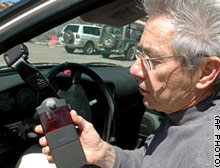 |
 |
 |
 Health & Beauty | April 2005 Health & Beauty | April 2005  
State Requiring Ignition Locks for DWI
 CNN CNN


| | Lobbyist Richard Roth shows the ignition interlock in Santa Fe, New Mexico. |
Chris Romero hops into his blue-and-white Ford pickup, clicks the ignition on and then off again, and reaches for what looks like a black cell phone hanging from his dashboard.

"Ready for test. Please blow," reads the display screen on the device.

Romero blows for about four seconds into a short plastic tube that sticks out of the top, then hears a beep. He has passed the test - the screen says, "Drive safely."

The twice-convicted drunken driver is, indeed, driving safely these days - thanks to his determination and the help of an ignition interlock, which would prevent him from starting the truck if he had been drinking.

"I just think it's a really good thing," said Romero, 42, who gave up alcohol after the device was installed three months ago. "It's almost a safety net."

With about 2,600 offenders a year ordered by courts to get interlocks, New Mexico has more of them currently installed per capita than any other state.

And that number could skyrocket. All convicted drunken drivers - nearly 13,000 annually - will be required to get interlocks under a new law Gov. Bill Richardson planned to sign on Wednesday.

While interlocks are employed to varying degrees in more than 40 states, New Mexico will be the first to require such broad use.

"What's unique about it is that it's the entire state, and a mandate for first offenders," said Paul Marques, senior research scientist with the Pacific Institute for Research and Evaluation in Calverton, Maryland.

Marques says that studies point to a big drop - 40 percent to 95 percent - in DWI re-arrests while interlocks are in use.

New Mexico has been grappling for years with an intractable DWI problem. New Mexico had the sixth highest rate in the nation for alcohol-related highway deaths in 2003. There were 213 fatalities and 3,500 alcohol-involved crashes, according to state officials.

The new law requires interlocks for one year for a first conviction, two years for a second, three years for a third, and for a lifetime - with appeals at five-year intervals - for a fourth or subsequent conviction.

Opponents say the new law is too punitive and would disproportionately affect the poor, who they argued are more likely to get convicted.

Advocates acknowledge that the system is not foolproof. Some judges don't order interlocks - even when the law says they must. And some offenders ignore interlock mandates, or install them and then drive other vehicles.

But Karen Sprattler, national director of public policy for Mothers Against Drunk Driving, says officials have learned that revoking licenses won't stop drunken driving.

"It doesn't take a piece of plastic to start a vehicle. ... We need to do something that goes beyond that," she said.

State Sen. Phil Griego, a recovering alcoholic who has been sober for four years, used the device for more than a year after his second DWI arrest.

"It really helped me when I got the urge to drink, knowing that if I had a drink I couldn't start my truck," he said.

During an hour-long lunch break from his job at a print shop, Romero's interlock demands that he test two more times, five minutes after he starts the truck and about 40 minutes later.

He has six minutes to comply with the retest demand, or else his horn honks until the truck turns off. Some interlock systems can shut off vehicles, but New Mexico doesn't allow that.

Without a license after his arrest last summer, Romero often ended up walking the five miles between home and work. His interlock has made it easier to keep his job.

"Some people call it an inconvenience," he said. "I say that it's just exactly the opposite, because you're still able to live your life." | 
 | |
 |



